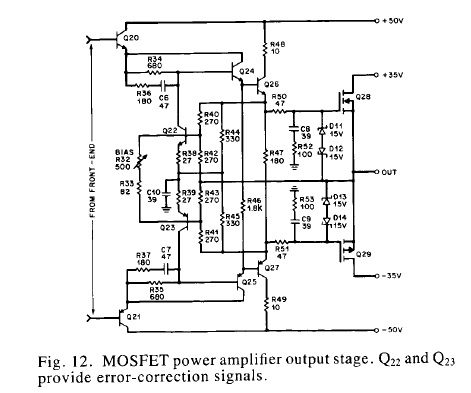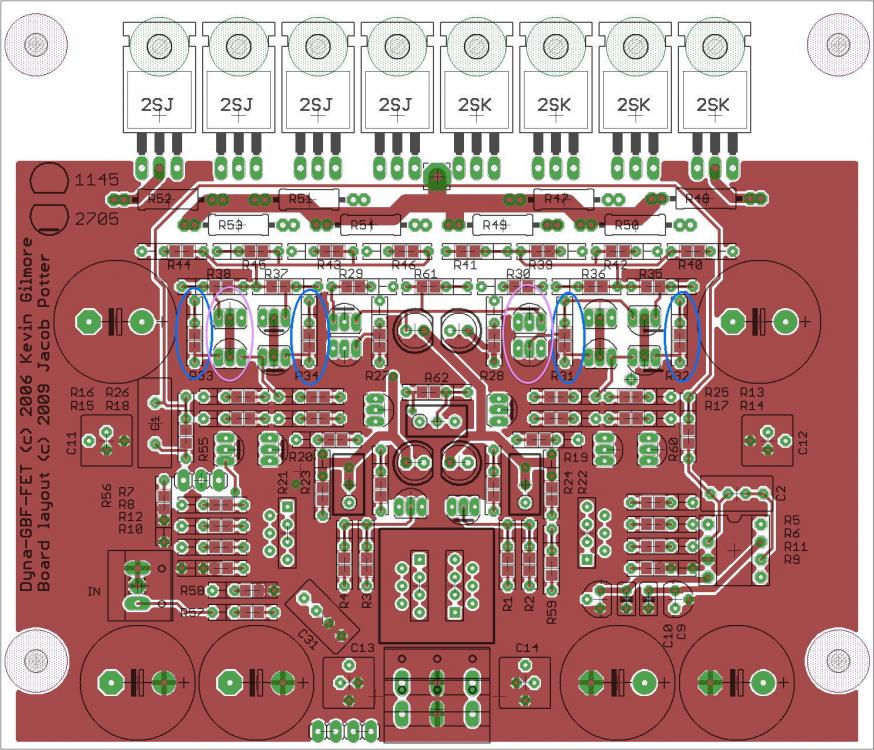-
Posts
8,474 -
Joined
-
Last visited
-
Days Won
7
Content Type
Profiles
Forums
Events
Everything posted by Pars
-
Not running any load right now, just straight into an maudio fw box. I do have a load box from tangent's plans (https://tangentsoft.net/audio/hp-dummy.html ) that I could toss on there. It has 33, 330 and I can't recall what else on it. EDIT: it has input and output jacks on it. Its been so long since I built it and used it that I forgot what all is on it
-
Ran RMAA on the 1st board (R ch). Everything looked fine. Re-ran it with the output zobel on, looked about the same, so my conclusion is it is working. I think for safety I will put on zobels ala Cordell. Need to find a near enough ground on the bottom. Set up the 2nd board with one pair of output devices. It biased right up, offset adjusted and looks good. I could not get this one to oscillate. No zobels or anything other than the stock configuration that I've settled on. I'll document what that is later. I'll add the 2nd pair of output devices and see what happens then. RightMark Audio Analyzer test : Dynahi-L DynaFET-R.pdf
-
Looks nice Michael! Only a 25VA transformer? I guess it is 700mA per secondary,
-
Started working on the other board last night, re-configuring it to match the first. I plan on bringing this up without the ferrite beads, but add the gate zobels to it, which I haven't tried yet. These seem more like a snubber than a zobel (cap -> resistor -> gnd). Cordell uses 39pf -> 100R; I don't have any 39pf but do have 33pf, so will probably increase the resistor a bit (120 or 150). The one Cordell uses seems to sim out at -3dB of > 10MHz. I may increase the cap to 100pf, but I'll try it with the 33pf first. I'll report back on how this behaves without the ferrites. I also plan on running RMAA on the first board, with a Dynahi board in the other channel. If things look amiss, or even if not, I will re-run this with the Amb zobel on the output and see what that looks like. If that looks better/different, I may put the Cordell zobels on this board and see what that looks like.
-
I would. Lately, orders from Arrow have been using fairly large antistat bags for everything. You can also buy them with ziploc-type closures. Places like OfficeMax or staples carry them I believe. Sent from my iPhone using Tapatalk
-
The best way that I have found is to use heavy stock and number in rows. I use 3M double sided tape to stick the devices on, then put it in an antistat bag. Add the measurement key, or just have that in a spreadsheet. Sent from my iPhone using Tapatalk
-
Brave man plugging good phones in [emoji4] The ones I am using are real crap Sony something or other. $5 and you overpaid... I would bet that the output zobel would take care of that for sure, the gate zobel (Cordell) probably, and the ferrites probably. Some people do quite involved zobels with inductors etc. from gate to drain. Sent from my iPhone using Tapatalk
-
Ahh, so that's what the software is for... now onto the maths! Very cool!
-
One other thing, some of the transistors in the diamond buffer section are running quite warm: Q26, Q23, Q18 and Q17 (purple ovals). Q26 is running ~60*C, and this is open air. I have some of the EDM sinks, but they push the transistor leads closer together than I like them. I also have some To92 heat sinks that I might try. DynaFET_schematic_marked.pdf
-
Katz may be very successful and experienced, but I've never heard of him, other than innerfidelity. Then again, I don't really listen to jazz, which going back to his reference recordings, seems to be where he exists. This isn't the first of his articles that I have read; guess he's just not my cup of tea. My undergrad is in music (percussion performance) and I spent quite a bit of time playing with symphony orchestras. I'm well aware that different examples of the same acoustic instrument sound different. My idea of a natural sounding recording would be this one, which in my opinion (and my brother's (trumpet)), is a recording that sounds to both of us like the CSO in orchestra hall, back when they had a phenomenal brass section (Herseth/Jacobs, et. al.). That said, I would rather listen to a so-so recording of a great performance than a SOTA recording of a so-so performance.
-
Just a bit more regarding the first paragraph: I haven't removed the ferrites as they were one of two things which killed the oscillation that I have tried, the other being output zobels as Amb describes in his B22 write up. Sent from my iPhone using Tapatalk
-
Yeah, so what? All this tells me is that he is used to processed sound. They don't normally try to make a band or performer sound just like they do in the studio, but better. Hence auto tune and all sorts of gimmicks. His "beloved O2" also colors my view a bit though I do trust Tyll's reviews and would probably buy something based on his recs. Sent from my iPhone using Tapatalk
-
Can't edit the sheet on my phone. Could you double my qty of unbal/bal and buffers (SMT) to 8/16? Thanks! Sent from my iPhone using Tapatalk
-
Yes they're needed. But haven't tried removing them. Knock on wood, I think I have a working board. I can get it to oscillate, but only with phones plugged in AND meter(s) connected to the ballast resistors. Pull the meters and it quits. I am going to put the gate zobels ala Cordell in but need some parts. 1) tried the mid feedback point and really bad oscillation. 2) the mid feedback point doesn't control gain (rail to rail). My spice sim confirms this unless I am configuring it wrong. 3) I am going to run RMAA on it w/Dynahi for other channel. That will hopefully give me a better idea if there are bad things going on that I am not seeing on the scope. 4) I had the input wiring reversed. Works much better now [emoji4]. Boards aren't marked for shit. The @!?# black solder mask makes it very difficult to see the traces as well. 5) note to anyone messing with these: the power connector is reversed from Dynahi. Sent from my iPhone using Tapatalk
-
I see the micro hanging on the USB port... what is this and the software for? Cool project? What kind of TT?
-
Yeah, that is really nice! Reminds me of a Seiko I had years ago, though yours is nicer. Sent from my iPhone using Tapatalk
-
Replaced the 221R gate stoppers with the original 47R. I had previously switched to some ferrite beads I got from Arrow (Fair-Rite 2773009112) and still no sign of oscillation. I put in the other set of FETs (4 total now) with beads and 47R gate stoppers. Still looked fine. On listening to it, I decided I wanted to isolate the R channel (DynaFET R, Dynahi L) and discovered that both channels were still playing with only the R input connected, so I need to figure out what is messed up in the input wiring. Probably why when it was oscillating, it appeared on both outputs. Oops. EDIT: Biased at ~150mA per device pair. Bias starts at 320mV and drops as amp warms up. 2R ballast resistors. Sent from my iPhone using Tapatalk
-

Whats the right size transformer for the original dynahi PSU
Pars replied to sbelyo's topic in Do It Yourself
Cool! Sent from my iPhone using Tapatalk -
Happy birthday Dan! Sent from my iPhone using Tapatalk
-
Yes, definitely use heavier copper for these. I was just saying that 1oz for normal boards (non-high current/voltage) is normally fine.
- 77 replies
-
I would question his reference material as well. To me, reference material is something like a symphony orchestra in a hall that you have been in and know. For his material, was he at the recording sessions and knows what it sounds like? His reference system also seems to be over processed. Must be a lot of a/d/a going on there. Sent from my iPhone using Tapatalk
-
Happy Birthday Al! Sent from my iPhone using Tapatalk
-
I've never had problems reworking 1oz boards (several cycles) if they are quality fab boards. 2oz is probably better though I don't know if 2oz is bonded to the substrate any better than 1oz is. I guess the additional copper must have some effect. Today's boards are a far cry from some of the '80s shit, where traces would lift if you looked cross-eyed at them Sent from my iPhone using Tapatalk
- 77 replies
-
- 3
-

-
Checked the actual board (marked the same as yours Kevin, from the group buy, lovely black soldermask), and the 2 electros up by the MOSFETs run from V+ to V-. I'd have to refresh my memory on bypassing, as I recall this being done with opamps before, but I would think to gnd would be better? Still running 1 pair of devices, removed the 1K gate stopper and put sockets in. With 221R everything looks fine, other than it is resembling lampizator construction technique. Marc: thanks for the Cordell link. I read quite a bit of that, plus took a look at his book on amplifier design. It appears that he always uses gate zobels consisting of 39pf->100R->gnd on his amps. He seemed to indicate that he always uses them.
-
Very clean soldering work John! Nice! Did you do any matching?



